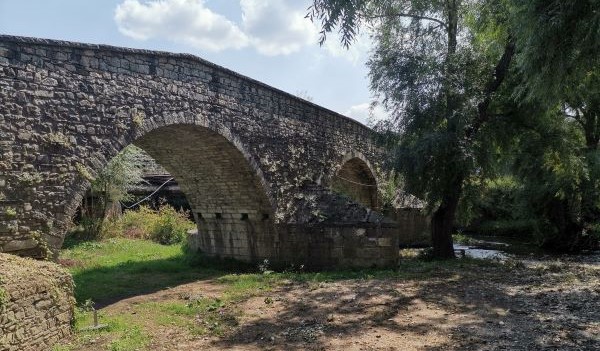
Il Ponte risale all’epoca tardo imperiale, tra il 248 d.C., anno dell’avvento al potere di Diocleziano, e il 305 d.C., anno in cui ebbe termine il regno dello stesso.
Il Ponte fu infatti voluto da Diocleziano in persona, lungo il tracciato della Via Herculea, che portava da Venosa (patria del poeta latino Quinto Orazio Flacco, più noto come Orazio) ad Eraclea. A pianta rettilinea, conserva oggi solo due piloni della struttura originaria. Nel corso del tempo ha subito numerosi interventi di restauro, preservando però la sua struttura lastricata in pietra. Il Ponte attualmente si presenta a tre luci, anche se originariamente doveva presentarne quattro, se si presta fede ad un particolare ad esso relativo contenuto in una stampa del 1703.
L’originaria denominazione del Ponte, stando alla tradizione, si ricollega al ricordo del Martirio di Sant’Oronzio che, giunto dall’Africa, non volendo abiurare la propria fede Cristiana, subì l’estremo supplizio proprio presso il fiume Basento. Vi è inoltre una leggenda che aleggia sul punto di San Vito. Alcuni abitanti del posto hanno assistito ad un fenomeno particolare, che solitamente avviene durante la notte del solstizio d’estate. Un carro trainato da due cavalli giungerebbe nei pressi del vecchio ponte costeggiando il fiume, arrivato a metà i cavalli verrebbero spronati al galoppo da un cocchiere invisibile per poi gettarsi nel fiume. Quanti hanno assistito a questa scena, dicono di essersi immediatamente sporti al di là del parapetto senza però trovare alcuna traccia della misteriosa carrozza fantasma.
Ponte San Vito, also known as the “Roman Bridge”, overlooks the river between via della Fisica and viale del Basento, and it is one of the testimonies of the Roman era present in the city of Potenza. The bridge dates back to the late imperial era, between 248 AD, the year of Diocletian power, and 305 AD, the year in which the reign of the same ended. The bridge was made by the will of Diocletian, along the route of the Via Herculea, which led from Venosa (birthplace of the Latin poet Quinto Orazio Flacco, better known as Orazio) to Eraclea. With a rectilinear plan, today it preserves only two pylons of the original structure. It has undergone numerous restorations, preserving its stone-paved structure.
The original name of the bridge, according to tradition, is linked to the memory of Sant’Oronzio who, coming from Africa, wanting not to deny his Christian faith, suffered the extreme torture right at the Basento river. There is also a legend: some locals have witnessed a particular phenomenon, which usually takes place during the summer solstice night. A cart drawn by two horses arrived near the old bridge along the river galloped by an invisible coachman and then jumped into it. Those who witnessed this scene said that they immediately went to search for the ghost carriage, without finding any trace of him.
Testo e foto a cura dei volontari del progetto di Servizio Civile “………… c’è TURISMO e CULTURA a POTENZA”
FONTI:
epotenza.it
basilicando.it
loscrignodelmistero.webnode.it




